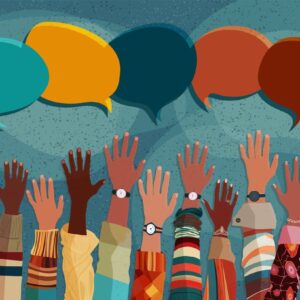
In January 2025, the Donald Trump administration canceled CBP One, the Customs and Border Protection mobile application that migrants used to schedule asylum appointments at the southern US border.
The action, implemented without transition or replacement, left people trapped between borders. In April, the Trump administration announced that an estimated 985,000 people who were granted humanitarian parole and entered the country legally through the app would be now in “irregular status” and that their two-year work permits would be thus canceled. In short, these 985,000 people could no longer legally work in the United States and were at risk of deportation. The CBP app instead was transformed into a “voluntary self-deportation” portal.
In the wake of these changes, many migrant rights organizations have stepped in. Some offer free legal counsel, while others document abuses and file strategic lawsuits. In shelters and encampments, advocates are working daily to support migrants through a system no longer functional.
To learn more, NPQ spoke with representatives of a number of migrant justice nonprofit groups.
What Was CBP One?
CBP One was designed by the Joe Biden administration as a way for migrants to enter the country legally at a time when irregular entries were overwhelming customs officials at the border, and the government was facing harsh criticism for its inability to manage entry.
Although CBP One was pitched as “efficient,” its function resembled a digital wall…the system enabled remote containment.
Launched in October 2020 as a U.S. Customs and Border Protection (CBP) initiative, CBP One aimed to streamline asylum processing by digitizing interviews scheduling and capping the number of people who could request asylum. By using the app, the U.S. government tried to avoid irregular crossings by using this pre-screening process and make anyone who didn’t, automatically ineligible for asylum.
Although CBP One was pitched as “efficient,” its function resembled a digital wall. By requiring migrants to initiate procedures from outside US territory, the system enabled remote containment—regulation without responsibility. The algorithms were opaque, with no explanation for how cases were prioritized.
The app, in short, was flawed from the start. Users reported persistent glitches, vanishing appointments, algorithmic opacity, and limited language access—as the app was available only in English and Spanish. For many Indigenous language speakers, these limitations amounted to exclusion. Human rights organizations also warned about serious privacy risks posed by the app.
Also, CBP One required smartphones, mobile data, and digital fluency—resources many migrants in shelters, camps, and rural towns often lacked.
This approach aligned with past policies like “Remain in Mexico” and Title 42, which forced asylum-seekers to stay in countries unequipped to provide protection. In both cases, migrants were left exposed to violence, trafficking, and official neglect.
Despite these shortcomings, CBP One had represented a step forward in terms of legal access to the United States. The estimated 985,000 people with asylum claims, who had already entered the United States under humanitarian parole, have had their permits revoked. They now risk indefinite arrest, deportation, daily fines, and long-term visa bans.
How Are Migrants Affected by the App Shutdown?
In conversation with NPQ, Reinaldo Ortuño Gutierrez, medical coordinator for Doctors Without Borders in Mexico and Central America, stated that “the suspension of the CBP One increases the risks for migrants because it leaves them in a legal and humanitarian limbo.”
He explained that those who already had appointments and those who were waiting for them lost all possibility of legally entering the United States, becoming trapped in Mexico without options for a dignified life, without resources, and with little chance of accessing legal forms of residency.
An estimated 985,000 people with asylum claims who were granted humanitarian parole and entered the country legally…have had their permits revoked.
In addition, Ortuño said that vulnerable migrants will be exposed to more violence. “A cyclical violence that increases or deepens the already precarious mental health of women, children, and men of all ages,” he said.
“In general terms,” Ortuño added, “one of the main risks we’ve observed—especially through the domino effect triggered by the sudden suspension—is that many individuals were left stranded along Mexico’s northern border, and even in other parts of the country.”
Willmer José Hernández Subero, coexecutive director of FM4 Paso Libre (“Paso Libre” means “Free Passage” in English), a nonprofit based in Jalisco, Mexico, offered similar views. He told NPQ that “those already granted appointments and physically present at points of entry were caught off guard, as the cancellation came at the very moment they were preparing to cross.”
Hannah Flamm, who is deputy director of policy at International Refugee Assistance Project, similarly informed NPQ that “there is no alternative to CBP One in place, in the sense that it has not been replaced with an alternative system through which people seeking safety, to which they are entitled under US law, can become a part of that process to seek asylum or otherwise be paroled into the United States.”
What Academic Studies Say About the CBP One Shutdown
A recent study by researchers at El Colegio de México, conducted in collaboration with scholars from the University of Toronto and El Colegio de la Frontera Norte, examines the effects of CBP One’s cancellation on access to asylum.
The research concluded that the revocation represents a “sharp and worrying turn in US immigration policy,” creating a “legal and humanitarian vacuum” that “leaves hundreds of thousands of people trapped in Mexico, many in precarious conditions, without viable alternative to either continue their migration or return to their countries of origin.”
Civil society-based migrant justice organizations in Mexico are grouped under the umbrella of the Migrant Defense Organizations’ Network (REDODEM), a coalition of human rights defenders supporting migrants and refugees. The network encompasses 42 shelters and collectively establishes a care route for migrants in Mexico who have travelled from all over Latin America to attempt reaching the US border.
“It’s a care pathway—welcoming the person, which is central to our service model. We conduct a needs-based interview to assess factors like how long they’ve been in Mexico, their means of entry, and what they plan to do next. We’re not a detention center; individuals are free to make their own decisions about staying or leaving,” Subero explained.
A just asylum system demands…systems designed with legal guarantees, human oversight, and community inclusion.
Grassroots tech initiatives have also emerged from communities—Telegram channels with verified updates, multilingual guides on asylum rights, and interactive maps of shelter networks. Still, community efforts cannot replace government obligations.
“I was in Guatemala in May at a shelter for displaced people. I met both a family that had been waiting for a CBP One appointment in Mexico—and, following Trump’s inauguration and the suspension of CBP One—gave up. It took months for them to be able to return to Guatemala, and then they were continuing their journey farther south to try to find safety in another country,” Flamm recounted.
Toward a Justice-Based Digital Migration System
CBP One’s cancellation, as noted, was a mixed bag. On the one hand, it was better to have a system for receiving asylum applicants than the current non-system of the Trump administration.
On the other hand, the migrant experience with CBP One, when it was operating during the Biden administration, was hardly positive.
A just asylum system demands a rethinking of the role of technology in immigration. Experts stressed the need for systems designed with legal guarantees, human oversight, and community inclusion.
This means multi-channel access (digital and in-person), multilingual interfaces, appeals mechanisms, and migrant participation in tech development. It also calls for limits on algorithmic decision-making in life-altering procedures like asylum. Because, as long as access to rights depends on an app, refuge will remain an unsurmountable privilege. A return to 2023 and 2024 policy, in short, would be far removed from the demands of migrant justice.













